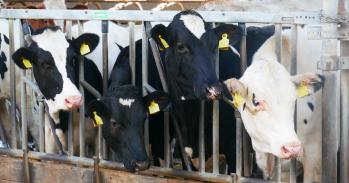
Mathematical modelling is an important weapon in the armoury against crop disease, as plant epidemiologists demonstrated when they turned their sights on root madness in sugar beet.
Mathematical modelling is an important weapon in the armoury against crop disease, as plant epidemiologists demonstrated when they turned their sights on root madness in sugar beet.
By the time a farmer has identified symptoms in their own fields they have unwittingly been exporting the pathogen on shared contractor’s agricultural machinery to their neighbour’s fields.
Professor Chris Gilligan
For sugar beet farmers, the appearance of yellowing patches in a field of sugar beet is an alarming sight. It could signal the presence of ‘root madness’, or rhizomania, and a potential reduction in their root sugar yield by 50–60%.
Diseases like rhizomania – which was first identified in Italy almost 60 years ago and now occurs in all the major sugar beet growing areas of the world – are a frequent and recurring problem in crop production, causing a reduction in potential food yields year upon year.
Breeding disease resistance and deploying pesticides have made remarkable progress in crop protection. But such strategies are not always feasible, particularly for emerging epidemics where appropriate methods may not yet exist. Another route, known as containment, is to destroy the crop and prohibit its further growth on the infected farm.
Monitoring the effectiveness of any kind of crop protection is vitally important, and mathematical models that track and predict disease, such as those created by Professor Chris Gilligan and his team in the Department of Plant Sciences, are helping to provide policy makers and regulators with the basis on which to make crucial strategic decisions.
Sugar beet rhizomania is among the many plant diseases that the Cambridge scientists have modelled. Their work, in close collaboration with government policy makers at the Department for Environment, Food and Rural Affairs (Defra), has helped both to gauge the effectiveness of containment strategies for this potentially devastating disease and to curb the potential for a future epidemic.
Keeping ahead of the virus
“The difficulty with rhizomania,” explained Professor Gilligan, who is a Biotechnology and Biological Sciences Research Council Professorial Fellow, “is the infection can be asymptomatic and the pathogen, beet necrotic yellow vein virus, can be readily spread by a soil-borne fungus through the movement of infested soil. In fact, by the time a farmer has identified symptoms in their own fields they have unwittingly been exporting the pathogen on shared contractor’s agricultural machinery to their neighbour’s fields.”
Strenuous efforts to contain the disease adopted by the Ministry of Agriculture, Fisheries and Food (MAFF, now Defra) involved annual surveys, destroying symptomatic plants on a field basis and prohibiting sugar beet cropping on affected fields. An additional, farm-scale measure was also introduced by the sugar beet industry: any growers worried about the disease status of their neighbour’s farm could transfer their sugar beet quota to farmers in regions of reduced risk.
Both schemes were discontinued when a partially resistant variety of sugar beet became available. However, the virus continues to evolve, and an aggressive strain has emerged that overcomes previously resistant varieties of sugar beet, highlighting the importance of the continuing development of resistant strains and of evaluating the effectiveness of control strategies.
The mathematical model developed by the Gilligan group looked at the relative success of field-scale versus farm-scale containment, using data from the initial infestation of rhizomania in East Anglia in 2000.
Their simulations were able to predict the relationship between the effectiveness of containment and the behaviour of growers, both in terms of how aware they are of the disease state of their neighbours’ fields and how risk averse they are in terms of passing on their quota as soon as their neighbours detect rhizomania.
“The simulations show that the field-scale approach fails to prevent invasion because, by the time the symptoms appear, the virus has already spread,” explained Professor Gilligan. “The farm-scale approach however works well, so long as most farmers sell their quota as soon as their neighbours detect the disease. Interestingly, the model shows that this strategy is robust to non-compliance – most but not all farmers have to comply for it to work.”
The research on matching control with inherent epidemic scales was originally funded by MAFF and British Sugar PLC. It now continues in the development of a mathematical toolkit to predict the outcome of control strategies to protect crops worldwide and safeguard food security.
For more information, please contact Professor Chris Gilligan (cag1@cam.ac.uk) at the Department of Plant Sciences.
This work is licensed under a Creative Commons Licence. If you use this content on your site please link back to this page.





